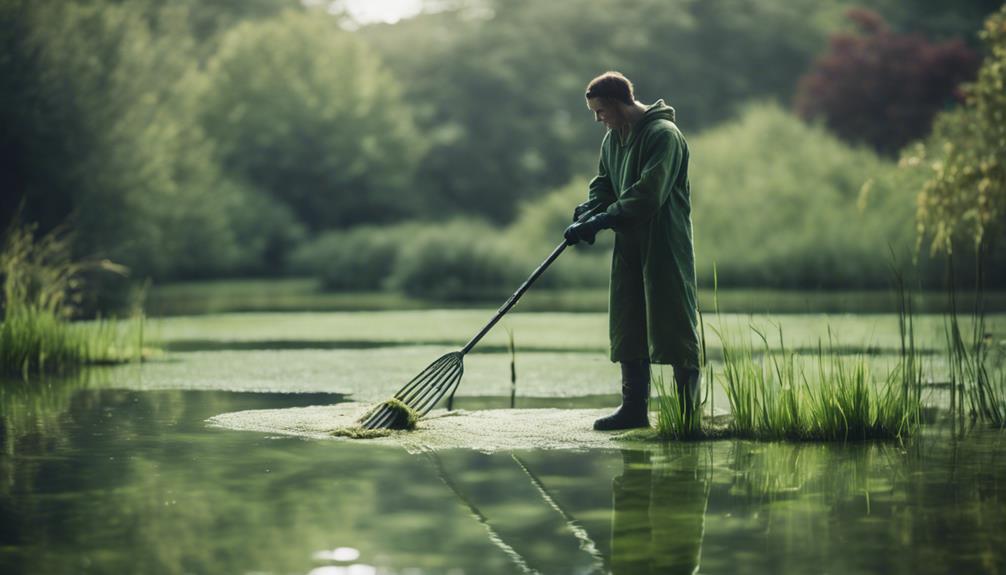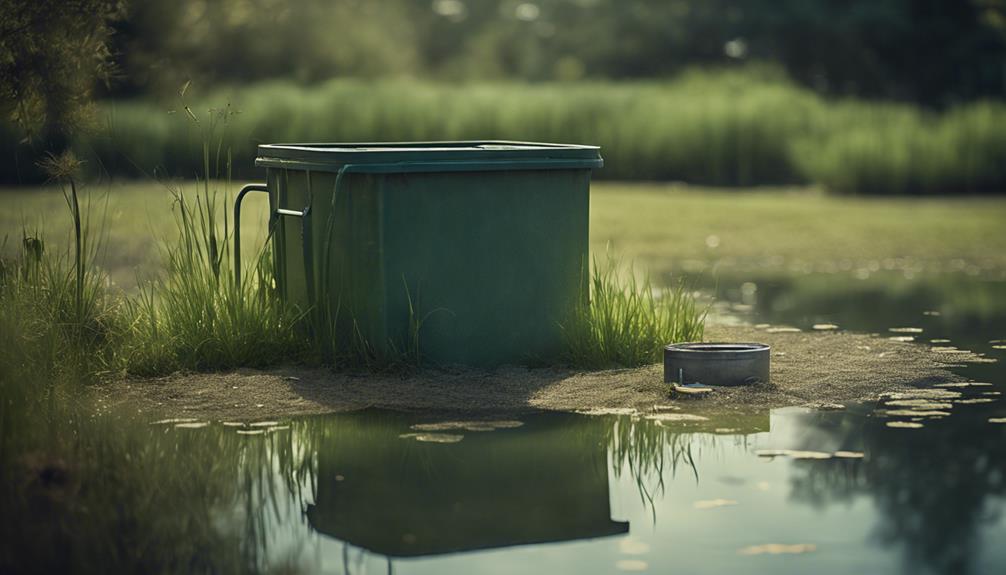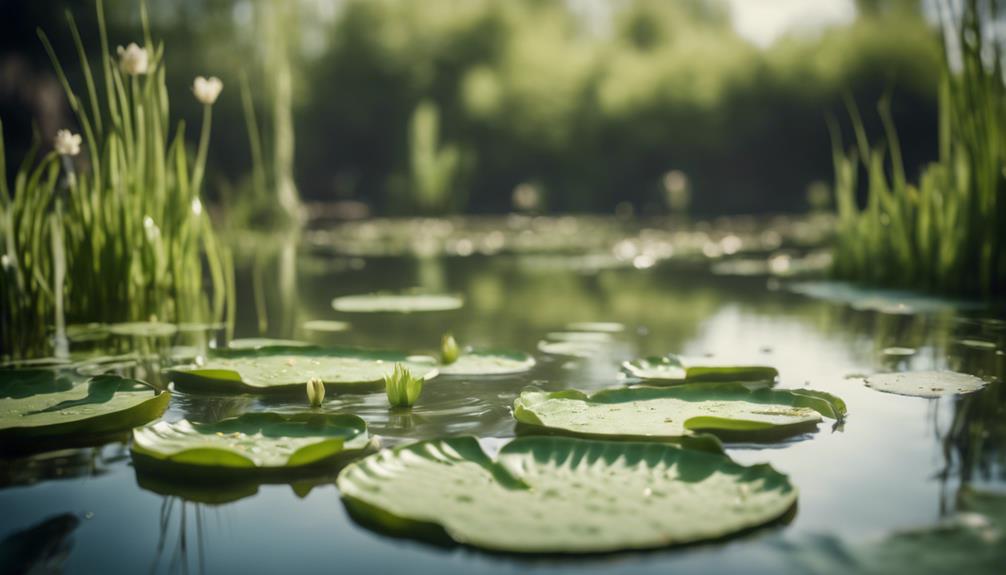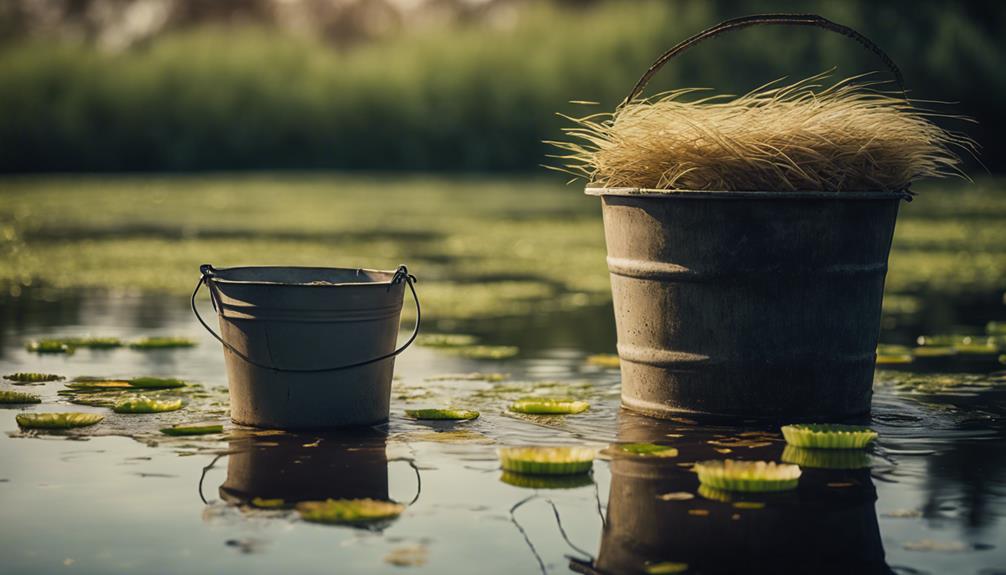You're likely aware that algae growth can quickly turn your serene pond or pool into a murky, green nightmare. To regain control, try these 10 natural homemade methods: manual removal, barley straw, beneficial aquatic plants, beneficial bacteria, introducing algae-eating fish and snails, limiting nutrient sources, aeration methods, natural algaecides, DIY remedies like baking soda and borax, and non-invasive methods like sonic wave cleaners and UV light technology. By exploring these approaches, you'll discover how to create a balanced ecosystem that suppresses algae growth and maintains a healthy, thriving environment.
Table of Contents
Key Takeaways
- Manual removal of algae with protective gear and a mesh bag is an effective and immediate solution for pond owners.
- Introducing beneficial aquatic plants like water lilies, cattails, and duckweed can outcompete algae for nutrients and reduce growth.
- Barley straw releases compounds that inhibit algae growth, providing a gradual and long-lasting control method for ponds.
- Beneficial bacteria like Bacillus, Nitrosomonas, and Pseudomonas can break down organic matter and consume excess nutrients, preventing algae growth.
- Limiting nutrient sources by removing debris, avoiding overfeeding, and using skimmers can prevent algae growth and promote a balanced ecosystem.
Natural Remedies for Algae Control
When seeking to control algae growth in your pond, you can turn to several natural remedies that have been proven effective in inhibiting algae development.
One approach is manual removal, which offers immediate results, although it may require periodic skimming for ponds prone to regular algae outbreaks.
Another method is to utilize barley straw, which releases compounds that inhibit algae growth, providing a gradual and long-lasting control method.
By incorporating barley straw into your pond, you can naturally control algae populations and create a healthier environment for your aquatic life.
Additionally, you can introduce beneficial aquatic plants that compete with algae for nutrients, helping to keep algae populations in check.
This natural approach not only reduces algae growth but also enhances the overall aesthetic of your pond.
Using Aquatic Plants to Combat Algae
As you explore the world of aquatic plants for algae control, you'll need to weigh several key factors when selecting the right plants for your water feature.
You'll want to choose plants that are well-suited to your pond's conditions and can effectively outcompete algae for resources.
Plant Selection Criteria
To effectively utilize aquatic plants as a natural algae control method, you must carefully select species that satisfy specific criteria, including their ability to thrive in your pond's unique conditions and outcompete algae for resources.
When choosing plants, consider their light requirements, tolerance to varying water temperatures, and adaptability to your pond's pH levels. Water lilies, for instance, are an excellent choice as they can absorb excess nutrients that fuel algae growth.
Plants and algae compete for the same resources, so selecting species that can outcompete algae is vital. Algae need nutrients like nitrogen, phosphorus, and potassium to grow, so plants that can absorb these nutrients will hinder algae growth.
Look for plants with high nutrient uptake rates, such as cattails or duckweed, which can effectively reduce algae populations. By selecting the right plants, you can create a balanced ecosystem that suppresses algae growth and maintains a healthy pond environment.
Water Lily Benefits
You can harness the natural algae-fighting potential of water lilies by incorporating them into your pond's ecosystem, leveraging their exceptional ability to absorb excess nutrients and outcompete algae for resources.
As a pond owner, you'll appreciate the benefits of water lilies in controlling algae growth.
Water lilies absorb excess nutrients, such as nitrogen and phosphorus, that algae need to thrive.
Water lilies provide shade, which reduces the amount of light available for algae growth.
Water lilies, like other aquatic plants, produce oxygen as a byproduct of photosynthesis, which can help combat low oxygen levels that favor algae growth.
Water lilies provide a habitat for beneficial bacteria that consume algae and other organic matter, further reducing algae growth.
Duckweed Advantages
Duckweed's exceptional growth rate and ability to cover up to 90% of a pond's surface make it an effective natural solution for outcompeting algae and reducing its growth.
As you consider using aquatic plants to combat algae, duckweed's advantages become clear. Its tiny leaves absorb excess nutrients, such as nitrogen and phosphorus, from the water, reducing the availability of these nutrients for algae growth.
This means you'll see a significant decrease in algae blooms. Plus, a single duckweed plant can produce thousands of new plants in just a few days, making it an efficient natural solution for combating algae.
Additionally, duckweed provides shade, which can inhibit algae growth by reducing the amount of sunlight that reaches the water. As an added benefit, duckweed can serve as a natural food source for some aquatic animals, such as fish and birds.
Manual Removal of Blanketweed Algae

Blanketweed algae's rapid growth necessitates prompt manual removal to prevent its suffocating grasp on your pond's ecosystem. You must take action to physically remove this invasive species before it chokes out your aquatic life. Manual removal is an effective way to control blanketweed algae, and it's a task you can undertake yourself.
Wear protective gear: Gloves, goggles, and a long-sleeved shirt will protect you from the algae's slimy texture and any potential irritants.
Use a mesh bag: This will help you collect the removed algae, preventing it from breaking apart and spreading further.
Target the roots: Gently dig up the algae, making sure to remove as much of the root system as possible to prevent regrowth.
Dispose of the algae properly: Bag the removed algae and dispose of it in a sealed container to prevent it from spreading to other waterways.
Barley Straw for Algae Prevention
One effective and eco-friendly approach to preventing algae growth in your pond is to harness the natural properties of barley straw. This natural method is non-toxic and releases compounds that inhibit algae growth when it decomposes. To get started, you'll need to add 1-2 bales of barley straw per acre of pond surface. Replace the straw every 2-3 months to maintain its effectiveness.
Here's a breakdown of what you can expect from using barley straw for algae prevention:
| Aspect | Effectiveness |
|---|---|
| Green water algae | High |
| Blanketweed | High |
| Blue-green algae | Low |
Keep in mind that barley straw is most effective against green water algae and blanketweed, but may not be as effective against other types of algae. It's also important to note that this method is a gradual process that requires patience and consistent maintenance. You may need to wait several weeks to see noticeable results. By combining barley straw with other natural algae control methods, such as introducing beneficial bacteria or aquatic plants, you can create a multi-faceted approach to algae management and enjoy a healthier, more balanced pond ecosystem.
Beneficial Bacteria for Algae Control

When it comes to controlling algae growth, you'll want to explore the benefits of introducing beneficial bacteria to your aquatic environment.
These microorganisms can outcompete algae for resources, effectively reducing its presence.
Bacteria Types
By introducing beneficial bacteria like Bacillus and Pseudomonas into your pond or pool, you can harness their natural ability to break down organic matter and consume excess nutrients, thereby controlling algae growth. These microorganisms are specifically designed to outcompete algae for resources, making them an effective natural solution for algae control.
Nitrosomonas: Converts ammonia into nitrate, reducing the availability of nitrogen for algae growth.
Bacillus: Breaks down organic matter and consumes excess nutrients, preventing algae from thriving.
Pseudomonas: Effective in breaking down organic matter and reducing nitrogen levels.
Nitrobacter: Completes the nitrogen cycle by converting nitrite into nitrate, making it unavailable to algae.
Bacteria Application
You can apply beneficial bacteria to your pond or pool through various methods, including adding commercial bacterial cultures to the water or introducing them through natural means, such as adding compost or manure that contains these microorganisms.
By doing so, you're providing your pond with a natural way to break down organic matter, reducing the nutrients available for algae growth and thereby controlling algae populations.
To maximize the effectiveness of beneficial bacteria, introducing them in conjunction with manual removal of algae is crucial. This combination approach can provide a more thorough solution to algae control.
You can also use beneficial bacteria in conjunction with other natural methods, such as barley straw and algae-eating fish and snails, to create a multi-faceted approach to manage algae.
Regular monitoring is necessary to verify the effectiveness of beneficial bacteria in controlling algae, as environmental factors and nutrient levels can impact their efficacy.
Algae-Eating Fish and Snails
In aquatic ecosystems, introducing algae-eating fish and snails can be a highly effective and environmentally friendly method for controlling algae growth. These aquatic life forms feed on algae naturally, reducing the need for chemical treatments. By incorporating them into your aquatic system, you can create a balanced ecosystem where algae growth is kept under control.
Siamese Algae Eaters: These fish are known to feed on various types of algae, including green, brown, and red algae.
Amano Shrimp: These shrimp are effective at controlling algae growth and are easy to care for.
Mystery Snails: These snails are voracious eaters of algae and can be used in both freshwater and brackish water systems.
Plecos: These fish are specialized to feed on algae and can be used in larger aquatic systems.
Remember to research and choose the right species for your specific aquatic system, and guarantee you provide them with a suitable environment. By introducing these algae-eating fish and snails, you can reduce fish waste and create a thriving ecosystem where algae growth is under control.
Limiting Nutrient Sources for Algae

Limiting the nutrient sources available to algae is a critical step in controlling its growth, as the presence of excess nutrients can negate the benefits of introducing algae-eating fish and snails.
As you work to prevent algae, crucially, you must identify and reduce the nutrients that fuel algae growth. One common culprit is overfeeding your fish, which can lead to a buildup of excess nutrients.
To prevent this, only provide your fish with the amount of food they can consume within a few minutes.
Regularly removing dead leaves, plants, and other organic debris can also help reduce nutrient loads and prevent algae growth.
Consider installing equipment like skimmers to automate the removal of debris, keeping your pond cleaner and less conducive to algae growth.
Additionally, be mindful of the fertilizers and chemicals you use around your pond, as they can contain phosphates that contribute to algae growth.
Aeration Methods for Algae Prevention
As you explore aeration methods for algae prevention, you'll discover that increasing water circulation is vital in preventing algae growth.
By introducing aeration systems, you can boost oxygen levels and create an environment where aerobic bacteria thrive, breaking down organic matter and keeping algae at bay.
Now, let's examine how water circulation, oxygen-rich water flow, and fountain aeration benefits can work together to prevent algae overgrowth in your pond.
Water Circulation Boost
By incorporating aeration methods into your pond's design, you can create a water circulation boost that prevents algae growth by promoting a healthy balance of oxygen and nutrients.
This is vital, as algae overgrowth can lead to an unbalanced ecosystem and even harm aquatic life.
Promotes aerobic bacteria growth, which breaks down organic matter and prevents algae overgrowth.
Maintains a balanced ecosystem, reducing the likelihood of algae growth.
Increases water circulation, preventing stagnant water and uneven nutrient distribution.
Reduces dissolved oxygen, making it difficult for algae to thrive.
Oxygen Rich Water Flow
You can further enhance your pond's water circulation boost by incorporating oxygen-rich water flow through aeration methods, which are specifically designed to prevent algae growth.
By increasing oxygen levels, you create an environment that's inhospitable to algae. Proper aeration can reduce the likelihood of algae growth by increasing water circulation and oxygenation, which helps break down organic matter that fuels algae growth.
Aerobic bacteria, beneficial microorganisms that thrive in oxygen-rich environments, can help break down organic matter and prevent algae growth when aeration methods are implemented.
In your pond, you can achieve aeration through the use of air stones, which release oxygen into the water, or windmills, which create water circulation and increase oxygen levels.
By implementing these methods, you can create a well-aerated pond or pool that reduces the need for algaecides and other chemicals, promoting a healthier and more balanced ecosystem.
As a result, you'll enjoy a cleaner, more sustainable environment that's less prone to algae growth.
Fountain Aeration Benefits
Fountain aeration systems, strategically placed in your pond or lake, effectively combat algae growth by introducing oxygen-rich water into the environment, thereby disrupting the stagnant conditions that favor algae development. By doing so, you create an environment that's less conducive to the growth of algae.
Increased Oxygen Levels: Fountain aeration can increase oxygen levels by up to 30%, making it difficult for algae to thrive.
Improved Water Circulation: Fountains can help reduce stagnation and stratification in the water, promoting a more balanced ecosystem.
Even Nutrient Distribution: A gentle circulation pattern helps distribute oxygen and nutrients evenly throughout the water, further inhibiting algae growth.
Reduced Algae Blooms: A well-designed fountain aeration system can reduce algae blooms by up to 70%, resulting in clearer water and a healthier ecosystem.
As a natural treatment, fountain aeration is an energy-efficient and eco-friendly method for preventing algae growth. By incorporating fountain aeration into your pond or lake management strategy, you can enjoy a cleaner, healthier, and more balanced aquatic environment.
Natural Algaecides for Pond Care

When it comes to natural algaecides for pond care, several methods have proven effective in controlling algae growth, from barley straw to beneficial bacteria.
You can get rid of algae by introducing barley straw, which releases compounds that inhibit algae growth, providing a gradual and long-lasting control method.
Another natural algaecide is beneficial bacteria, which break down organic matter, reducing nutrients available for algae growth and helping to maintain a balanced ecosystem in your pond.
By incorporating these natural algaecides, you can reduce algae populations and create a healthier environment for your aquatic life.
In addition to these methods, you can also introduce algae-eating fish and snails, such as grass carp and Nerite snails, to provide a natural way to control and reduce algae populations in your pond.
Manual removal of algae using specialized rakes or nets provides a quick solution to reduce algae mass and can be combined with beneficial bacteria for enhanced effectiveness.
DIY Algae Remedies for Pool Owners
Modifying your pool maintenance routine to incorporate natural remedies can help you regain control over algae growth and create a safer, more enjoyable swimming environment.
As a pool owner, you're likely looking for effective and eco-friendly solutions to combat algae growth.
Modify your pool vacuum: Use a mesh bag and cotton balls or a microfiber mitt to collect small debris like algae in above-ground pools.
Try natural cleaning agents: Baking soda breaks up algae for scrubbing, while borax is effective against white algae. Saltwater pools can even produce natural chlorine to kill algae.
Remove algae nutrients: Orenda water treatment can remove phosphate and other nutrients that algae feed on, making it a natural and effective solution for algae control in pools.
Use sonic wave cleaners: These devices cause algae cells to vibrate and break down, providing a natural and non-invasive method for controlling algae growth in pools.
Frequently Asked Questions
What Kills Algae Naturally?
You'll find that introducing algae predators, like zooplankton or snails, alongside aquatic plants that absorb excess nutrients, beneficial bacteria that break down organic matter, and natural filters like sand or gravel, can effectively kill algae naturally in your ecosystem.
What Household Product Kills Green Algae?
You can utilize several household products to kill green algae, including baking soda to raise pH levels, white vinegar to lower pH levels, hydrogen peroxide to oxidize algae cells, and borax powder to dehydrate the algae.
How Do I Keep Algae Out of My Aquarium Naturally?
You maintain aquatic balance and achieve water clarity by prioritizing tank maintenance, selecting plants that absorb excess nutrients, and ensuring a harmonious environment, thereby preventing algae growth and creating a thriving aquarium ecosystem.
What Is a Home Remedy for Green Algae?
Like a stealthy invader, green algae can creep into your tank, but you can outsmart it by maintaining good algae prevention habits, such as improving water circulation, regular tank cleaning, and reducing sunlight – the perfect trio to keep algae at bay.
Conclusion
As you've explored these 10 natural homemade algae control methods, you've likely discovered a subtle yet profound truth: a balanced ecosystem is the most potent remedy of all.
By embracing harmony with nature, you've taken the first step in transcending the perpetual battle against algae.
By working in tandem with the environment, you'll find that the most effective solutions often lie in the subtle nuances of the natural world, rather than in harsh chemicals or quick fixes.

